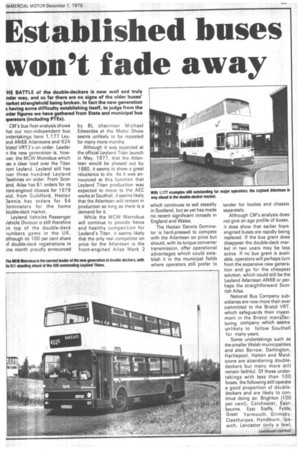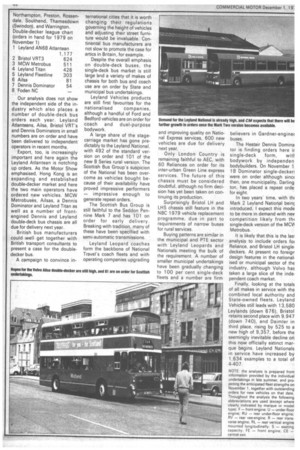Established buses won't fade away
Page 45

Page 46

If you've noticed an error in this article please click here to report it so we can fix it.
HE BATTLE of the double-deckers is now well and truly 'rider way, and so far there are no signs of the older buses' market stranglehold being broken. In fact the new generation s having some difficulty establishing itself, to judge from the order figures we have gathered from State and municipal bus perators (including PTEs).
CM's bus fleet analysis shows hat our non-independent bus indertakings have 1,177 Leyand AN68 Atlanteans and 624 3ristol VRT3's on order. Leader n the new generation is, howAter, the MCW Metrobus which as a clear lead over the Titan rom Leyland. Leyland still has )ver three hundred Leyland 'leetlines on order, From Scotand, AiIse has 81 orders for its ront-engined chassis for 1979 Ind, from Guildford, Hestair Dennis. has orders for 54 Dominators for the home Jouble-deck market, Leyland Vehicles Passenger lehicle Division is still therefore an top of the double-deck lumbers game in the UK, although its 100 per cent share Df double-deck registrations in Dne month proudly announced
by BL chairman Michael Edwardes at the Motor Show seems unlikely to be repeated for many more months.
Although it was expected at the official Leyland Titan launch in May, 1977, that the Atlantean would be phased out by 1980, it seems to show a great reluctance to die. As it was announced at this function that Leyland Titan production was expected to move to the AEC works at Southall, it seems likely that the Atlantean will remain in production as long as there is a .demand for it.
While the MCW Metrobus will continue to provide fierce and healthy competition for Leyland's Titan, it seems likely that the only real competitor on price for the Atlantean is the front-engined AiIse Mark 2 which continues to sell steadily in Scotland, but as yet has made no recent significant inroads in England and Wales.
The Hestair Dennis Dominator is hard-pressed to compete with the Atlantean on price but should, with its torque converter transmission, offer operational advantages which could establish it in the municipal fields where operators still prefer to tender for bodies and chassis separately.
Although CM's analysis doesnot give an age profile of buses, it does show that earlier frontengined buses are rapidly being replaced. If the bus grant does disappear the double-deck market in two years may be less active. If no bus grant is available, operators will perhaps turn from the expensive new generation and go for the cheapest solution, which could still be the Leyland Atlantean AN68 or perhaps the straightforward Scottish Ailsa.
National Bus Company subsidiaries are now more than ever committed to the Bristol VRT, which safeguards their investment in the Bristol manufacturing company 'which seems unlikely to follow Southall for many years.
Some undertakings such as the smaller Welsh municipalities and also Barrow, Darlington,. Hartlepool, Halton and Maidstone are abandoning doubledeckers but many more still remain faithful. Of those undertakings with less than 100 buses, the following still operate a good proportion of doubledeckers and are likely to continue doing so: Brighton (100 per cent), Colchester, Eastbourne, East Staffs, Fylde, Great Yarmouth, Grimsby, Cleethorpes, Hyndburn, Ipswich, Lancaster (only a few), Northampton, Preston, Rossendale, Southend, Thamesdown (Swindon), and Warrington. Double-decker league chart (orders in hand for 1979 on November 1) 1 Leyland AN68 Atlantean 2 Bristol VRT3 624 3 MCW Metrobus 511 4 Leyland Titan 426 5 Leyland Fleetline 303 6 Ailsa 81 7 Dennis Dominator 54 8 Foden NC Our analysis does not show the independent side of the industry which also places a number of double-deck bus orders each year. Leyland Atlanteans, Ailsa, Bristol VRT's and Dennis Dominators in small numbers are on order and have been delivered to independent operators in recent months.
Export, too, is increasingly important and here again the Leyland Atlantean is notching up orders. As the Motor Show emphasised, Hong Kong is an expanding and established double-decker market and here the two main operators have ordered new vehicles. MCW Metrobuses, Ailsas, a Dennis Dominator and Leyland Titan as well as a number of frontengined Dennis and Leyland double-deck bus chassis are all due for delivery next year.
British bus manufacturers could well get together with British transport consultants to present a case for the doubledecker bus.
A campaign to convince in ternational cities that it is worth changing their regulations governing the height of vehicles and adjusting their street furniture would be invaluable. Continental bus manufacturers are not slow to promote the case for artics in Britain, for example.
Despite the overall emphasis on double-deck buses, the single-deck bus market is still large and a variety of makes of chassis for both bus and coach use are on order by State and municipal bus undertakings.
Leyland Vehicles products are still first favourites for the nationalised companies, although a handful of Ford and Bedford vehicles are on order for coach and duel-purpose bodywork.
A large share of the stagecarriage market has gone predictably to the Leyland National, with 492 of the standard version on order and 101 of the new B Series rural version. The Scottish Bus Group's suspicion of the National has been overcome as vehicles bought because of their availability have proved impressive performers — impressive enough to generate repeat orders.
The Scottish Bus Group is still faithful to the Seddon Pennine Mark 7 and has 101 on order for early delivery. Breaking with tradition, many of these have been specified with semi-automatic transmissions.
Leyland Leopard coaches form the backbone of National Travel's coach fleets and with operating companies upgrading and improving quality on National Express services, 600 new vehicles are due for delivery next year.
Only London Country is remaining faithful to AEC, with 60 Reliances on order for its inter-urban Green Line express services. The future of this chassis must be considered doubtful, although no firm decision has yet been taken on continuing its production.
Surprisingly Bristol LH and LHS chassis still feature in the NBC 1979 vehicle replacement programme, due in part to requirements of narrow buses for rural services.
Buying patterns are similar in the municipal and PTE sector with Leyland Leopards and Nationals meeting the bulk of the requirement. A number of smaller municipal undertakings have been gradually changing to 100 per cent single-deck fleets and a number are firm believers in Gardner-engine( buses.
The Hestair Dennis Domina tor is finding orders here ir single-deck form, witt bodywork by independen bodybuilders. On November 1 18 Dominator single-decker: were on order although sinc( then, one municipality, Darling ton, has placed a repeat orde for eight. In two years time, with thi Mark 2 Leyland National beim introduced, I expect this mode to be more in demand with nev competition likely from thi single-deck version of the MC' Metrobus.
It is likely that this is the lasanalysis to include orders foi Reliance, and Bristol LH single. deckers. At present no foreigr design features in the national. ised or municipal sector of th€ industry, although Volvo has taken a large slice of the independent coach market.
Finally, looking at the totals of all makes in service with the combined local authority and State-owned fleets, Leyland Vehicles still leads with 13,580 Leylands (down 676), Bristol retains second place with 9,947 (down 740), and Daimler in third place, rising by 525 to a new high of 9,357, before the seemingly inevitable decline on this now officially extinct marque begins. Leyland Nationals in service have increased by 1,634 examples to a total of 4-407.
NOTE: the analysis is prepared from information provided by the individual undertakings in late summer, and projecting the anticipated fleet strengths on November 1, together with outstanding orders for new vehicles on that date. Throughout the analysis the following abbreviations are used fexcept where clearly indicated by marque or model type): F — front engine: U — under-floor engine: RU — rear under-floor engine; RV — rear vee-engine; R — rear transverse engine, RL — rear vertical engine mounted longitudinally; S — seating capacity; FE — front engine; CE — central exit.


































































































































